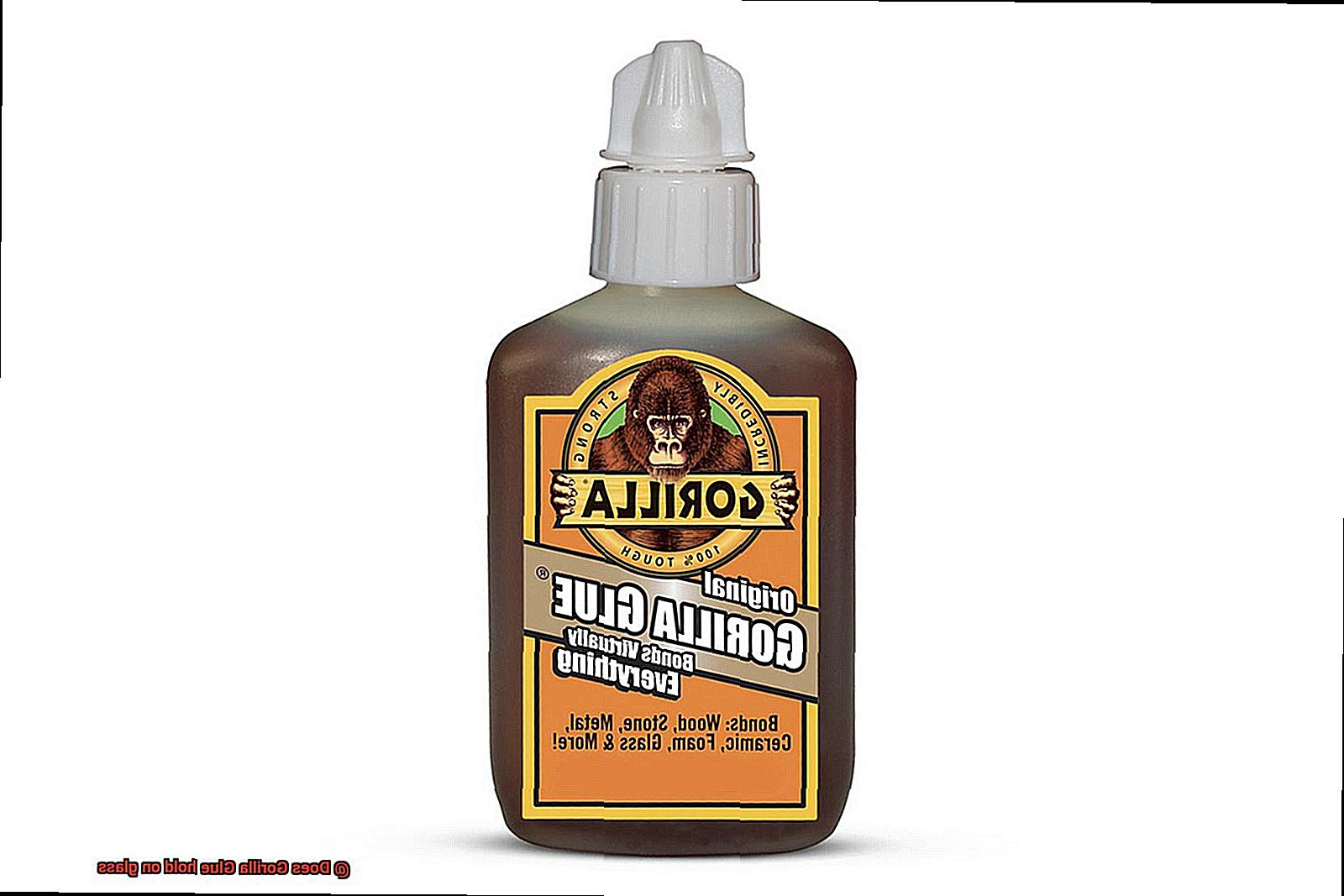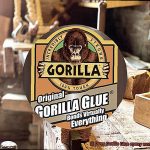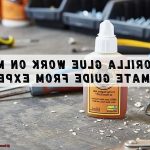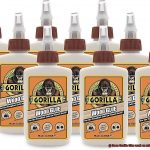Get ready to have your mind blown by the astonishing bonding powers of Gorilla Glue. We’re about to embark on a thrilling journey to uncover the truth behind a burning question that has perplexed us all: Does Gorilla Glue really hold on glass?
Picture this: a shattered glass coffee table, a beloved vase reduced to fragments, or a delicate glass figurine in ruins—heartbreaking scenes we’ve all encountered at some point. Desperate to salvage our cherished possessions, we’ve tried countless adhesives in search of a solution. But can Gorilla Glue, famous for its legendary strength, truly rescue our glass treasures?
Before we reveal the answer, let’s delve into the key points surrounding this scorching topic. First and foremost, let’s explore the extraordinary qualities that set Gorilla Glue apart from its competitors. This adhesive has gained renown for its ability to bond almost anything—a true force to be reckoned with.
Now, let’s take a closer look at glass and its tricky surface. Unlike porous materials that readily soak up adhesives, glass poses a smooth and non-porous challenge. Yet, time and time again, Gorilla Glue has amazed both craft enthusiasts and professionals with its remarkable adaptability.
Throughout this captivating investigation, we’ll also dive into the process of using Gorilla Glue to bond glass and discuss the vital factors contributing to its success. From meticulous preparation techniques to precise curing times, we won’t leave any stone unturned.
So whether you’re an avid DIYer in search of innovative solutions or simply curious about satisfying your inquisitive mind, join us as we unveil the secrets behind Gorilla Glue’s grip on glass. Get ready to be astonished as we unravel mysteries and expose the truth—hold onto your seats.
What Is Gorilla Glue?
Contents
Prepare to be amazed as we delve into the world of Gorilla Glue – the adhesive powerhouse that has revolutionized bonding. With its unparalleled strength and versatility, this adhesive has become a staple for professionals and DIY enthusiasts alike. In this article, we will explore what exactly Gorilla Glue is, its remarkable features, and how it can effortlessly bond an array of materials together. Brace yourself for the wonders of this adhesive marvel.
Unleashing Unrivaled Strength:
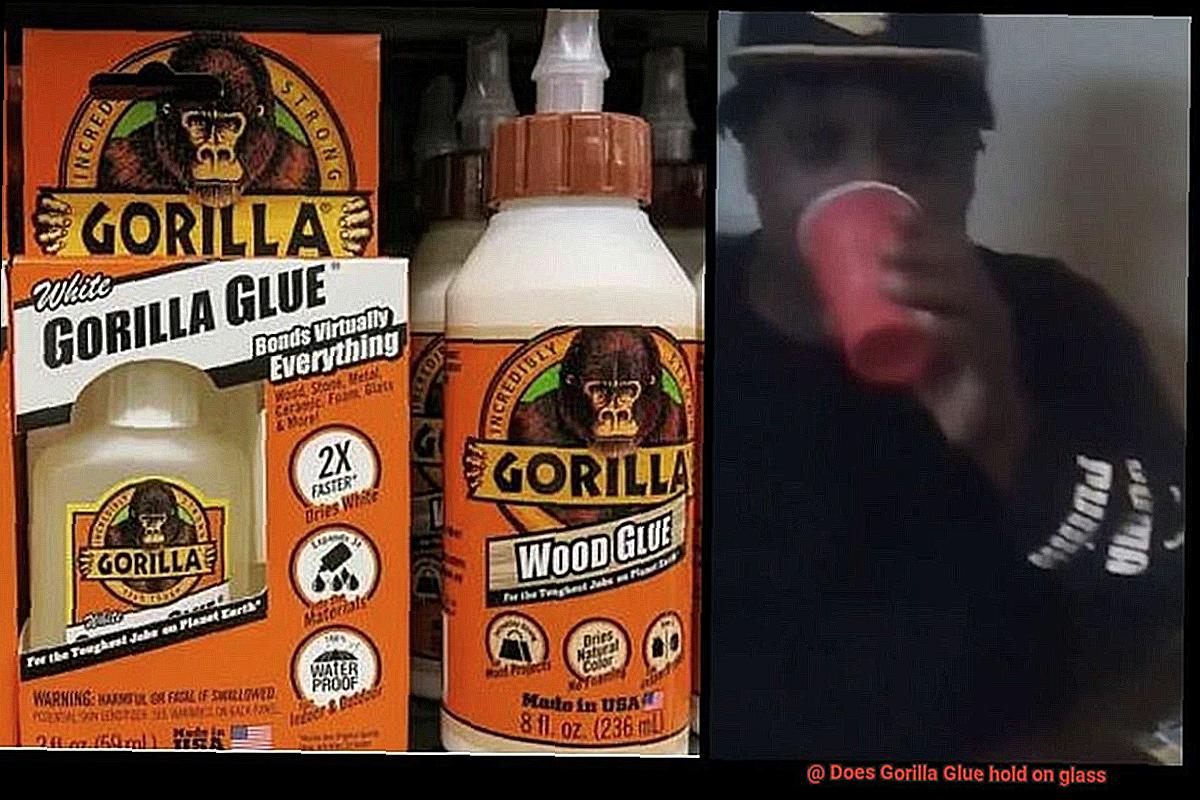
Gorilla Glue, a polyurethane-based adhesive, possesses an uncanny ability to create bonds that defy expectations. When applied, it expands into the material’s pores, resulting in an incredibly sturdy and long-lasting connection. From wood to metal, ceramics to stone, and even glass, Gorilla Glue reigns supreme as the go-to adhesive for various surfaces.
Versatility Takes Center Stage:
What sets Gorilla Glue apart is its remarkable versatility. No matter the project or repair at hand, this adhesive rises to the occasion. Its resistance to water and extreme temperatures makes it suitable for both indoor and outdoor applications. So whether you’re fixing a broken vase or creating a masterpiece on a glass surface, Gorilla Glue has got you covered.
Aesthetics Matter Too:
Strength alone is not enough – aesthetics play a vital role in many projects. Fear not. Gorilla Glue dries to a light tan color that seamlessly blends with most materials. This allows for a flawless and professional finish that enhances rather than distracts from your work’s overall appearance.
Expanding Boundaries:
Gorilla Glue pushes the boundaries of adhesive bonding through its unique expansion capabilities. During the curing process, it magnifies up to three times its original size, effortlessly filling any gaps or irregularities on the surfaces being bonded. This extraordinary feature ensures maximum coverage and eliminates weak points in your project.
Safety First:
While Gorilla Glue is a force to be reckoned with, safety should always be a priority during application. Contact with the skin can cause irritation, so handle this adhesive with care. Wearing gloves and taking precautions to prevent spills or excess application is highly recommended.
Can Gorilla Glue Be Used to Bond Glass?
Prepare to be amazed as we delve into the world of glass bonding with the incredible Gorilla Glue. Renowned for its extraordinary strength and versatility, this adhesive powerhouse has the potential to create robust connections on glass surfaces. However, before embarking on your glass-bonding adventure, there are crucial steps you must follow. Get ready to unlock the full potential of Gorilla Glue for all your glass bonding needs.
Step 1: Start with a Pristine Surface
Glass’s smooth and nonporous nature presents a challenge for adhesives seeking to establish a firm bond. Overcome this hurdle by meticulously cleaning the glass surface. Eliminate dirt, dust, and residue using a mild detergent or glass cleaner and a lint-free cloth. Remember, cleanliness is key to successful bonding.
Step 2: Roughen Up the Glass (Gently.)
Improve the adhesive’s grip on the glass by giving it a gentle roughening treatment. Use sandpaper or a fine-grit abrasive pad to create a slightly rough texture on the surface. Exercise caution not to apply excessive pressure, as we don’t want any glass casualties during this process.
Step 3: The Perfect Amount of Gorilla Glue
Remember, less is more when it comes to Gorilla Glue and glass bonding. Apply a small amount of adhesive onto one of the surfaces requiring bonding. Keep in mind that Gorilla Glue expands as it dries, so a thin layer suffices. Applying too much glue may result in messy overflow and compromise the clean bond you desire.
Step 4: Press and Hold
Now comes the moment of truth. Align the two glass surfaces carefully and press them together. Apply gentle but firm pressure for at least one hour to allow the adhesive to set. Avoid any movement or disruption during this time to ensure a rock-solid bond. Patience is key.
Step 5: Time to Cure
Resist the temptation to test your bond just yet. Let the glued glass object sit undisturbed for a minimum of 24 hours. This additional time permits complete drying and curing of the adhesive, ensuring maximum bond strength.
What Types of Glass Can Gorilla Glue Bond?
Glass is a mesmerizing material that can be found in many everyday objects, like windows and bottles. But have you ever wondered how glass pieces are joined together to create stunning designs? Well, the secret lies in an incredible adhesive called Gorilla Glue. This versatile glue has the power to bond different types of glass, making it a favorite among crafters and DIY enthusiasts. Let’s delve into the mesmerizing world of glass bonding and explore the types of glass that Gorilla Glue can work its magic on.
Soda-Lime Glass: The Everyday Marvel
Soda-lime glass is the unsung hero of our daily lives, used in windows, bottles, and even some exquisite decorations. When it comes to bonding soda-lime glass, Gorilla Glue truly shines. Its strong adhesive properties make it a perfect match for this type of glass. To achieve a firm and lasting bond, it is crucial to prepare the glass surface properly by thoroughly cleaning it and gently roughening it. This helps the glue adhere better, ensuring your creations withstand the test of time.
Borosilicate Glass: The Heat-Resistant Wonder
If you’ve ever used a Pyrex dish or encountered laboratory equipment, you’re familiar with the mighty borosilicate glass. Known for its resistance to heat and durability, this glass poses no challenge for Gorilla Glue. By following the same preparation steps as with soda-lime glass, you can confidently fix cracked dishes or embark on exciting glass art projects. With Gorilla Glue as your ally, your borosilicate creations will stay intact.
Tempered Glass: The Safety Maverick
Tempered glass is a safety champion, surpassing regular glass in strength and durability. However, its unique manufacturing process introduces tension within the material, making it more challenging to bond. While Gorilla Glue can bond with tempered glass, the tension may weaken the bond compared to other glass types. For projects involving tempered glass, it is advisable to explore other adhesives specifically designed for this purpose.
Laminated Glass: The Multilayered Marvel
Laminated glass, commonly found in car windshields and safety glass applications, is a true marvel of engineering. It consists of multiple layers of glass bonded together with a special interlayer material. Gorilla Glue can form a bond with the glass layers, but it may not adhere as effectively to the interlayer material. To ensure a strong and secure bond, it is imperative to meticulously clean the surface and remove any debris or contaminants that could hinder adhesion.
Cleaning and Preparing the Glass Surfaces
Imagine the satisfaction of flawlessly bonding your glass creations with Gorilla Glue. But before you embark on this creative journey, it’s crucial to give your glass surfaces the attention they deserve. In this comprehensive guide, we’ll take you through the art of cleaning and preparing glass surfaces, ensuring a bond that will stand the test of time. Let’s dive in and discover the secrets to glue-ready glass surfaces.
Sparkling Clean: A Prerequisite for Perfection
The first step on our path to glue-ready glass surfaces is achieving a sparkling clean canvas. Armed with a mild detergent or specialized glass cleaner, unleash your cleaning prowess. Scrub away dirt, grease, and pesky fingerprints using a soft cloth or sponge, leaving no corner or edge untouched.
Rinse, Rinse, Rinse: Banish Residue for Good
Now that your glass surface is squeaky clean, it’s time to bid farewell to any lingering soap residue. Let clean water cascade over every inch of the glass, ensuring that no remnants of cleaning agents remain. A pristine surface sets the stage for a powerful bond.
Dry with Care: The Final Touch of Perfection
Moisture is the archenemy of successful glass bonding, so it’s time to dry your surface with meticulous care. Enlist the help of a lint-free cloth or a trusty paper towel, leaving no trace of moisture behind. Remember, patience is key – only proceed when your glass surface is completely and unequivocally dry.
Stubborn Stains? No Match for Specialized Solutions
Should stubborn stains or adhesive residues dare to mar your glass surface, fear not. Equip yourself with a specialized glass cleaner designed specifically for these challenges. Following the instructions provided, wield this potent remedy sparingly to protect the integrity of your glass. The extra effort invested now will yield impeccable results.
Rough It Up (Gently): Unleashing the Power of Texture
In the realm of smooth and shiny glass surfaces, a gentle touch of roughness can work wonders for bonding strength. Enter the realm of sanding, armed with fine-grit sandpaper. Apply gentle circular motions, ensuring not to apply excessive pressure that could mar your glass with unwanted scratches. Embrace this delicate dance, creating a textured canvas primed for optimal adhesion.
How to Apply Gorilla Glue to Glass
When it comes to bonding glass surfaces, Gorilla Glue proves to be a versatile and powerful adhesive. Although not specifically designed for glass, with proper preparation and application, it can create a strong and secure bond. In this comprehensive guide, we will walk you through the process of applying Gorilla Glue to glass, ensuring successful results.
Prepare the Glass Surface:
To ensure optimal adhesion, it is crucial to start with a clean glass surface. Eliminate any dirt, grease, or residue by using a mild detergent and water. Thoroughly dry the glass surface before proceeding. A pristine surface sets the stage for a superior bond.
Enhance Adhesion:
To improve the adhesive bond, gently roughen the glass surface using fine-grit sandpaper or a specialized glass etching solution. This delicate abrasion creates a slightly rough texture, allowing the Gorilla Glue to grip firmly. Be cautious during this step to avoid scratching or damaging the glass.
Apply Sparingly:
When it comes to applying Gorilla Glue to glass, less is more. This adhesive expands as it cures, so using too much glue can result in messy overflow. Apply a thin layer of Gorilla Glue onto one of the surfaces that will be bonded together. Remember, a little goes a long way with this potent adhesive.
Press and Secure:
Achieving a strong bond requires precise alignment and even pressure distribution. Carefully align the glass surfaces and apply firm pressure across the entire area. To ensure consistent pressure and prevent any movement that could compromise the bond, utilize clamps or tape to hold the pieces together while the glue cures.
Allow Sufficient Drying Time:
Patience is key when working with Gorilla Glue on glass. While the glue typically sets within 2 hours, it is crucial to allow a full 24 hours for complete curing. Rushing this process could weaken the bond and compromise its strength. Ensure that you give the glue ample time to dry and harden before subjecting it to any stress or pressure.
Drying Time for Gorilla Glue on Glass
Look no further than Gorilla Glue – the adhesive powerhouse that will hold your glass together like never before. But before you dive into your project, let’s explore the fascinating world of drying time for Gorilla Glue on glass. Understanding this crucial aspect is key to achieving a successful bond.
The drying time for Gorilla Glue on glass is influenced by several factors. Temperature, humidity, and the amount of glue applied are all players in the game of speedy bonding. Generally, you can expect Gorilla Glue to dry on glass surfaces within 1-2 hours. However, bear in mind that this timeframe can fluctuate depending on the aforementioned factors.
To achieve optimal results, it is highly recommended to let the glued glass object cure for a minimum of 24 hours. This generous window allows the glue to fully dry and create an unyielding bond. During this drying process, it is imperative to keep the glued pieces in a well-ventilated area with excellent air circulation. This not only expedites the drying process but also ensures a bond that can withstand the test of time.
Temperature and humidity have their say in the drying time of Gorilla Glue on glass. Higher temperatures and lower humidity levels work as catalysts, accelerating the drying process. So if you’re in a hurry to see your masterpiece come to life, find a warm and dry spot to set your glued glass object.
While waiting for the glue to dry completely, resist the urge to disturb or move the glued glass object. Any disruptions during the drying period can jeopardize the bond and result in a weaker hold. Exercise patience and let the glue work its magic undisturbed.
Here’s an important tip: Gorilla Glue expands as it dries. Therefore, it is crucial to apply only a thin layer of glue on your glass surfaces. This precautionary measure prevents excessive expansion and potential damage to your beloved glass object. In case any excess glue squeezes out during application, fear not. Simply grab a damp cloth or sponge and remove it before it dries completely.
Once the glue has fully dried, brace yourself for a bond that will withstand the test of time. Gorilla Glue is renowned for its strength and durability on various materials, including glass. However, to ensure optimal results, it is always wise to follow the manufacturer’s instructions.
Alternatives to Gorilla Glue for Bonding Glass
As the demand for strong and reliable glass bonds continues to grow, it’s essential to explore alternatives to Gorilla Glue. In this captivating exploration, we will dive into the world of alternative adhesives, revealing their unique advantages and empowering you to make an informed choice for your glass bonding needs.
Epoxy Resin: The Indomitable Force
When it comes to durability and strength, epoxy resin takes the lead. Trusted by industries such as automotive, aerospace, and construction, epoxy resins form unyielding bonds between glass surfaces. With their exceptional resistance to chemicals and temperature fluctuations, these powerhouses guarantee a long-lasting bond that can withstand even the harshest conditions.
UV-Curing Adhesives: The Swift and Transparent Solution
For seamless glass-to-glass bonding, UV-curing adhesives are the ultimate game-changers. These adhesives rely on ultraviolet light to cure, resulting in an invisible finish. Not only do they create a robust bond, but they also offer lightning-fast curing times, enabling you to complete projects with unrivaled efficiency.
Silicone Adhesives: Flexibility Meets Durability
When your bonded glass is subjected to movement or vibrations, silicone adhesives rise to the occasion. Their remarkable flexibility and resilience make them ideal for outdoor projects or high-temperature environments. With outstanding resistance to moisture and extreme temperatures, silicone adhesives provide a reliable solution that guarantees longevity.
Double-Sided Adhesive Tapes: Convenience Redefined
Say goodbye to complex bonding processes with double-sided adhesive tapes. These ingenious tapes feature adhesive on both sides, effortlessly creating a strong bond between glass surfaces without the need for curing or drying time. Whether you’re mounting glass panels or securing mirrors, double-sided tapes offer unparalleled convenience for your glass bonding endeavors.
Cyanoacrylate Adhesives: Unleash the Super Glue for Glass
When it comes to super glues for glass bonding, cyanoacrylate adhesives take the spotlight. However, it’s crucial to choose specialized formulations specifically designed for glass bonding. This ensures a strong bond without any visible residue. With the right cyanoacrylate adhesive, you can achieve remarkable results and unlock the true potential of glass bonding.
VQ2FTCk5iXI” >
Conclusion
In conclusion, Gorilla Glue is indeed capable of securely holding glass together.
Its strong adhesive properties create a bond that withstands the test of time. Whether you’re repairing a broken glass object or creating a unique glass art piece, Gorilla Glue provides the reliability and durability you need.
So go ahead, trust in the power of Gorilla Glue to hold your glass projects firmly in place.

